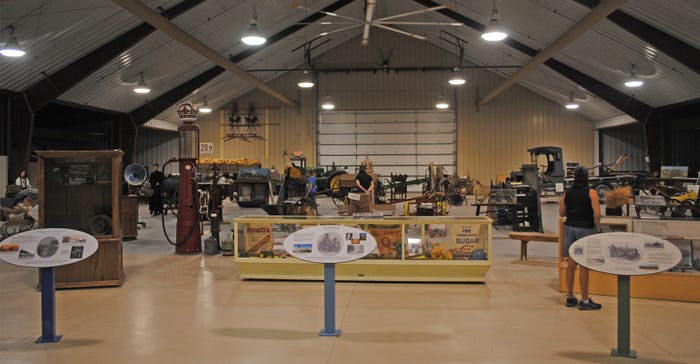
Nebraska is a diverse agricultural state, with a broad and interesting farming and ranching history, from east to west. Some of the state’s finest ag history museums and educational sites help to tell the story of Nebraska agriculture through time.
In our series of Nebraska Farmer virtual tours, we encourage teachers, ag students, 4-H and FFA members, farmers and ranchers, and ag history enthusiasts to enjoy this Panhandle museum that documents the unique agriculture practices and crops of the region, especially the North Platte River Valley, through the camera lens of Nebraska Farmer editors.
Legacy of the Plains Museum
The Nebraska Panhandle offers some of the most spectacular scenery in the state, especially in what could be called “Nebraska’s Landmark Country,” stretching from Courthouse and Jail Rocks at Bridgeport, past Chimney Rock at Bayard, and on to Mitchell Pass and Scotts Bluff National Monument at Scottsbluff and Gering.
These historic natural monuments were the same monuments that thousands of Oregon Trail and California Trail emigrants heading west passed from the 1840s to the 1860s and wrote countless diary entries about. These monuments were spectacular then and remain so today. The trails still are visible too, as swales that indicate a deep roadbed created from wagons traveling along a single path through Mitchell Pass.
As farmers and ranchers began to settle the North Platte valley and irrigation became available, they grew wheat, sugarbeets, dry edible beans and potatoes. On the High Plains, agriculture is different from much of the state’s corn and soybean country. That’s why the Legacy of the Plains Museum in Gering, located in the shadow of Scotts Bluff and directly in line with the history of the Oregon Trail, is such an important gem.
This is a combination of collections from the former Farm and Ranch Museum that was developed in 1988 as the Western Nebraska Society for the Preservation of Antique Farm Equipment, and the North Platte Valley Museum, founded in 1961 to collect and preserve the history and artifacts of the valley, particularly those related to Native American culture, emigrant trails, early settlement and the cattle industry.
When these two world-class collections joined forces to become the Legacy of the Plains Museum in 2013, a one-of-a-kind museum — providing comprehensive historical displays for visitors — was formed.
As you drive into the museum parking lot, Scotts Bluff National Monument is within sight, just down Nebraska Highway 92 west of Gering. The main exhibit hall, offices and gift shop, resembling a Midwestern barn, make up the centerpiece and headquarters of the museum grounds.
This massive hall, which opened in fall 2016, includes seven themed zones that cover different topics, including Prairie Pathways about trails and transportation; Grassland Empire that covers ranching and livestock; Beyond the Dust Bowl about dryland farming; Just Add Water covering irrigation; Taking Care of Business covering High Plains businesses; Be It Ever So Humble about domestic and home life; and the Eye of the Artist, which is a High Plains art gallery.
From an agriculture standpoint, Just Add Water covers how irrigation canals and dams helped farmers divert water to cropland in the valley, where sugarbeets, corn, dry edible beans and potatoes, among other crops, are raised.
Historic sugarbeet farm implements are among the most unique features of the museum. In the Beyond the Dust Bowl section, exhibits highlight stubble-mulch farming techniques and conservation efforts in the valley in the wake of the Dirty '30s. Ranchers won’t be disappointed, because the ranch life and western cattle trails are on display at the museum as well.
Outdoor exhibits on the grounds include the Wiedeman Farmstead House, originally located across the highway from the museum and relocated to the museum site. The house was owned by David and Marie Wiedeman, Germans from Russia who settled in the valley in 1919.
The exhibit includes a basement set in the 1930s and the main floor of the house set in the 1950s. The Gentry Log Cabin also is located on the site, built in 1870 from native logs cut in the Wildcat Hills and originally used as a schoolhouse on Pumpkin Creek.
Acquired by Benjamin Gentry in 1890 as a new home for he and his bride, the house was moved to the family’s farm east of Minatare. All four children in the family were born in that cabin. It was donated to the North Platte Valley Museum in 1968. When the museums merged in 2013, Legacy of the Plains moved the cabin to its current location, now facing south as it had originally in 1890. There also is a working Farm Blacksmith Shop on the museum grounds.
The library and archive at Legacy of the Plains includes rare publications, including books, newspapers, magazines, maps, manuscripts and other print resources, as well as a collection of farming equipment-related technical literature, audiovisual materials, homestead filings and land records. Researchers can use this massive collection of resource materials by appointment.
If you’d like to learn more about Legacy of the Plains, call the museum at 308-436-1989 or visit legacyoftheplains.org.
About the Author(s)
You May Also Like






